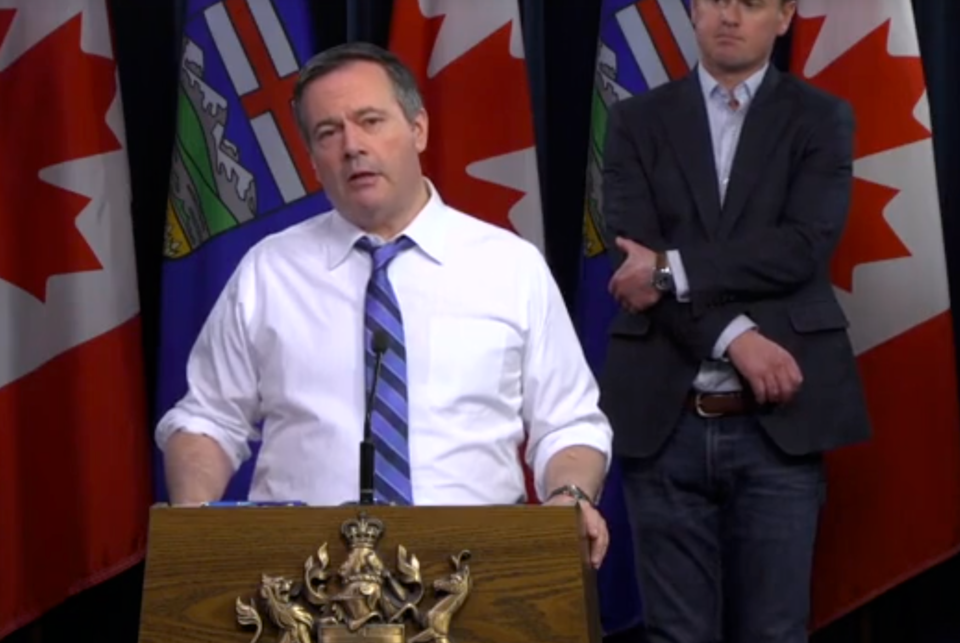Alberta Health Services plans to increase the intensive care capacity in the province by 1081 beds, up from the current 293 beds in Alberta.
On Wednesday, the province of Alberta released its modelling number on what it expects the COVID-19 pandemic to look like. The province outlined how it plans to drastically increase the health care capacity to face two possible scenarios: a probable scenario and an elevated one.
Probable scenario
From the beginning of the outbreak to the end of summer, the province could see as many as 800,000 infections, and between 400 and 3,100 deaths. With 4.371 million people living in Alberta, that would mean around 18 per cent of residents would contract the virus. In this scenario, between 0.05 per cent and 0.387 per cent of those who contract the virus would die.
During the probable scenario's peak, 736 to 900 people would be hospitalized in late May with 220 to 224 people needing critical care in late May to June.
The probable scenario projects the peak of infection to hit mid-May. Given the early and aggressive interventions taken by the province, this is the most likely scenario to occur. For every case of COVID-19, one to two more people are infected and this scenario is comparable to the more moderate growth seen in the U.K. and countries that have had some success in containing growth of COVID-19 cases.
Elevated scenario
The elevated scenario is less likely, but is still being planned for because if it were to happen it could have catastrophic impacts if the health care system became overwhelmed.
For this scenario to happen, every case of COVID-19 would result in two more people being infected. This is comparable to the more rapid growth initially seen in China's Hubei province.
If an elevated scenario were to happen, the province would see infections peak at the beginning of May and would have as many as 1 million infections and between 500 and 6,600 deaths. This scenario would see roughly 23 per cent of people in the province get infected with COVID-19. In this scenario, between 0.05 per cent and 0.6 per cent of people who contract the virus would die.
During the elevated peak, 1,491 to 1,649 people would need hospitalization at the beginning of May. The elevated peak would see 372 to 412 people requiring critical care by early May.
Extreme scenario
If Alberta hadn’t taken prudent measures to limit the infections spread in the province, the province would be facing an extreme scenario.
In this scenario, for every case of COVID-19, three more people would be infected. This scenario assumes limited and late interventions so that COVID-19 rapidly spreads through the population.
- RELATED: COVID cases in Canada top 18,000 and 400 deaths; Trudeau offers more aid
- RELATED: The latest developments on COVID-19 in Canada on April 8
If the province had no social distancing and public health orders in place, Alberta could see as many as 1.6 million infections and 32,000 deaths, which could be as many as 640 deaths per day.
“Our health system would collapse under the chaos of that scenario. Albertans won’t let that happen,” Kenney said in a television address on Tuesday night.
Health care capacity
Right now, there are 100 hospitals across the province, with 8,483 hospital beds, 295 ICU beds and 509 ventilators, but the province plans to continue to build capacity for sick Albertans.
AHS plans to have 2,250 COVID-19 designated acute care beds by the end of April. As of April 3, 1,935 are available for COVID-19 patients and new COVID-19 dedicated spaces are being brought online.
AHS is achieving this capacity by postponing scheduled surgeries, tests and procedures while ensuring urgent, emergent and oncology surgeries continue. They are also transferring patients who no longer require acute care to a community setting. AHS is also increasing occupancy in facilities while still maintaining physical distancing between patients and they are opening overcapacity, and new and decommissioned spaces.
ICU capacity
AHS plans to increase ICU capacity by 1,081 beds for COVID-19 patients by the end of April, if it is necessary. There are currently 293 ICU beds in the province
AHS will achieve this by adding ICU beds to existing ICU rooms, converting operating rooms and recovery rooms to ICU capacity, converting procedure and treatment rooms to ICU capacity and using new models of care, such as more aggressive use of step-down care.
Ventilator capacity
AHS plans to have 761 ventilators available by the end of April for COVID-19 patients, if necessary, to respond to a severe scenario. There are currently 509 ventilators available in the province.
Some 314 of those ventilators are currently dedicated to COVID-19 patients. To increase capacity, the province has bought more ventilators that are currently on order. Thirty-five have arrived while another 30 will arrive in May.
The province will repurpose 40 ventilators from the NAIT and SAIT Respiratory Therapy program, six from STARS and 25 from AADL Respiratory Outreach Program. An additional 30 will be repurposed from chartered surgical facilities.
The province will also use 305 alternative devices capable of mechanical ventilation, including transport, anesthetic and pediatric devices. The province will also get six ventilators from the Public Health Agency of Canada.



